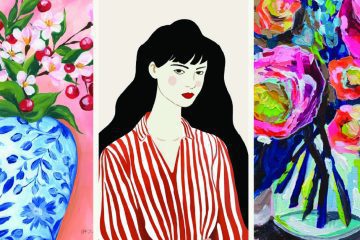Artificial intelligence (AI) is rapidly changing the way art is created, and this shift is particularly evident in abstract art. Traditionally, abstract art emphasizes color, texture, and emotion over realistic forms, offering artists the freedom to experiment and explore new ideas.
However, this freedom can also pose challenges, as many artists find the process of creating abstract art daunting, such as developing initial concepts to refining the final details.
With the advent of AI tools, the process has become significantly easier, faster, and more creatively dynamic. With the help of AI technology, talented artists can now access an endless stream of surface pattern design inspiration, allowing them to experiment with different designs and refine their works more efficiently.
Find out more about how AI is helping abstract artists at every stage of the creative process.
The Role of AI in the Creative Process
Creating abstract art is personal, and every artist may approach it differently. However, there are a few common steps in the process: coming up with ideas, developing them, refining the work, and finishing it. AI can help at each of these stages by providing tools that generate ideas, boost creativity, and improve techniques.
Look at how AI tools are making each step easier.
- Ideation: Inspiring New Ideas and Concepts
The first step in making abstract art is coming up with an idea, which can be tough. AI tools like DeepDream and RunwayML help artists try out different styles and come up with new ideas. Artists can upload their own images or use others to experiment with colors and designs. AI often gives surprising suggestions that inspire new thoughts. One common method, called style transfer, blends things like color, texture, and brushstrokes from one image to another, helping artists create unique and fresh works. These AI tools also provide surface pattern design inspiration, allowing artists to explore different patterns and textures to enhance their artwork.
- Experimentation: Playing with Patterns and Color
Once an idea is formed, the next step is to experiment with patterns, textures, and colors. AI tools like Artbreeder and DeepArt help artists by quickly creating different versions of their concept. These tools allow artists to change things like layout, color, and patterns in real time. AI can also make repeatable patterns and shapes, saving time by doing the adjustments automatically. Additionally, AI tools like Processing and P5.js let artists code their own designs, creating dynamic and changing artwork that would be difficult with traditional methods. These tools also offer surface pattern design inspiration, allowing artists to discover fresh patterns and textures to enhance their creations.
- Composition: Helping with Layout and Structure
AI helps artists create balanced artwork by suggesting changes to color, placement, and structure. Tools like Adobe Sensei analyze the design and recommend ways to improve it. AI can also find patterns in art and guide artists to create drafts that fit their vision. Tools like Google’s Magenta Studio help artists make complex and interesting layouts. These tools also provide surface pattern design inspiration, helping artists discover new patterns and textures to incorporate into their work.
- Refinement: Adding Detail and Texture
AI improves abstract art by adding textures and details quickly. Tools like Prisma and DeepArt can simulate brushstrokes and apply different styles like oil painting or watercolor. AI also adjusts color and texture in real-time, helping artists refine their work faster and more precisely. These tools also give surface pattern design inspiration, helping artists find new patterns and textures to improve their work.
- Finalization: Perfecting the Artwork
At the final stage, AI tools help artists make last-minute adjustments to perfect their art. AI can smooth out rough areas, enhance gradients, or remove mistakes. Software like Corel Painter helps artists add finishing touches and also makes sure the artwork looks great in both digital and print formats. These tools also provide surface pattern design inspiration, allowing artists to experiment with different patterns and textures as they add the final touches.
Also Read: How AI is Shaping & Influencing Abstract Art and Surface Pattern Design
In Conclusion
Creating abstract art has always been a unique journey for each artist. With AI tools, artists can now streamline the process, from generating ideas to finishing the artwork. AI helps with experimenting, refining designs, and perfecting details, all while maintaining the freedom and creativity of abstract art. These tools offer surface pattern design inspiration to artists looking for fresh patterns to use in their work.
As AI continues to improve, it will offer more opportunities for innovation. AI isn’t here to replace artists, but to support them, enhancing their creativity and opening up new possibilities.
FAQs
1. What is surface pattern design inspiration?
It’s the ideas or creativity behind making patterns, textures, or designs. These are often used in things like fabrics, wallpapers, or decorative items.
2. Can AI replace human creativity in designing patterns?
No, AI doesn’t replace creativity. It helps by providing tools to explore and try new things, but the final decisions still come from the artist.
3. How does AI make designing easier?
AI saves time by automating tasks like adjusting colors, creating seamless patterns, and testing variations. This lets designers focus on their ideas.
4. Can AI create repeating patterns?
Yes, AI can make seamless repeating patterns by aligning and adjusting them automatically, making it faster for designers.5. Where can I find surface pattern design inspiration?
You can use AI tools, explore nature, architecture, online libraries, or even everyday items. AI can also create suggestions based on photos or datasets.



0 Comments